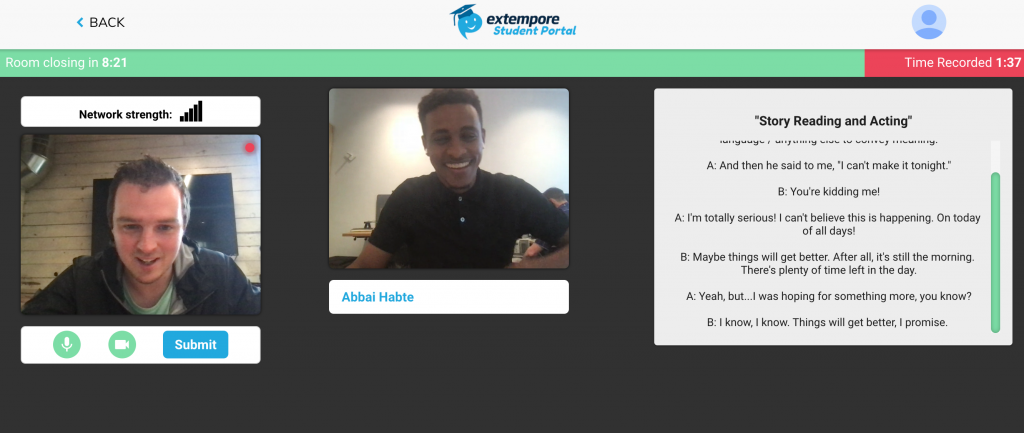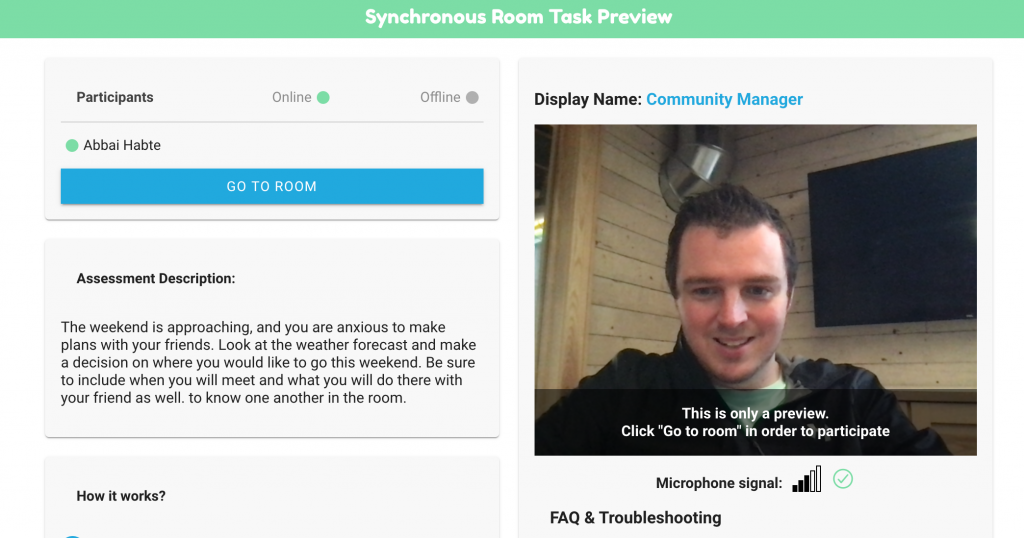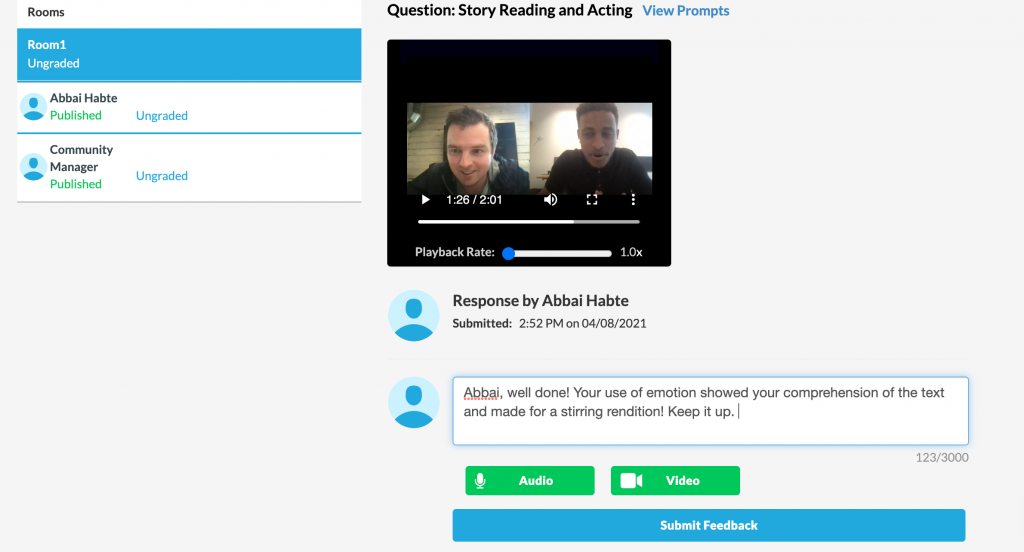
By now you've probably familiarized yourself with Extempore Sync, one of our newest features that allows for live interpersonal communication. And what a neat feature it is! And as a language teacher, there's nothing better to inspire new ideas for teaching and learning than a new online toy, err.... tool. But when that initial novelty wears off, we want to feel confident in putting this into practice.
So let's explore Extempore Sync then. What makes it unique? And what are some examples of its classroom usage?
What makes Extempore Sync different from normal breakout rooms?
A valid question. At first look, Sync appears to be what many of us have already grown accustomed to in the digital meeting world, a basic breakout room where users can interact with one another outside of a larger group. But if you look deeper, you'll see that there's more than meets the eye...
Clearly Displayed Task Prompts
For one, questions and task prompts are clearly displayed for all participants to view (and hear). Students can see their partners, task directions, and teacher-supplied images / videos all within the same browser window -- no need for opening multiple tabs and making sure everyone's on the same page. As soon as students join the room, everything they need is waiting for them.

Recordable and Reviewable Conversations
With Sync, recording activates as soon as one student joins the room, so students don't have to worry about finding the record button or wondering when to start and stop. Not only does this greatly simplify the technology burden on students, it also opens the door to student review and reflection post-assignment. More on that later.


Individualized, rubric-based feedback
The logistics of giving individual feedback for group assignments can be overwhelming at times, but Extempore makes this easy. On the grading page, instructors will see the same video response for each student in a given group but can leave unique feedback for each student. And this feedback can align with any rubric that you create on the platform.


Part 1: 5 Sample Tasks For Extempore Sync
Below you can find five unique tasks for Extempore Sync (if you read our post "Extempore Sync -- Everything You Need to Know," some of these might look familiar). Included for each task are a relevant rationale and objectives, as well as the task's content. Finally, learn how to modify these tasks for your class.
1) Basic Task — Introductions
A few words on this prompt. First, it's a perfect way (kinda like the Extempore 101 task) to introduce students to Sync, allowing them to get the feel for how it works and adapt to the interface. Relatedly, participants are encouraged not just to complete the task in the TL, but also (and some would say of equal importance) focus on non-linguistic interpersonal social skills. Are they making eye contact with their partner(s)? Is their body language welcoming and not standoffish? Are they listening to their interlocutor(s) and not interrupting? Factoring in these elements adds an extra layer to this simple exchange of hellos. See the full description below.
Description: You run into a new friend while studying abroad in Antarctica. By an extreme coincidence, your shared language is the TL you are both learning! Introduce yourself and get to know one another in the room.
Rationale / Can-do
- I can introduce myself in the TL to a new friend.
- Developing interpersonal skills outside of just using the language.
Prompt: Introduce yourself to your partner, asking appropriate questions to learn more about them. You might ask:
- What is your name?
- How old are you?
- Where are you from?
- What do you like to do in your free time?
Be sure to smile and be friendly to your newest acquaintance. They are nervous!
2) Basic Task — Low Pressure Dialogue
Sure, reading a dialogue out loud with a partner is not entirely a real-world task (but it is a pedagogical task), yet it's still one of the easiest ways to get students to produce the target language. There's also no pressure on students to produce their own language; all they have to do is simply read what's in front of them.
Outside of this, dialogues like the one below allow both speakers to practice using emotion and differentiated intonation in the TL. And when done properly, it's an excellent way for students to display comprehension.
Rationale / Can-do
- Pronounce words properly
- Convey emotion when speaking, even when the text is right in front of us
- Practicing the cadence / flow of a conversation / dialogue
Description: You've been wanting to practice acting skills with your classmates. Now's your chance! Read the script out loud playing your role. Be sure to use emotion and whatever else you need to do to convey meaning!
Prompt: First, choose between characters A and B. Then, read your characters part of the script out loud, using emotion / body language / anything else to convey meaning. Finally, switch roles and read again!
Script
A: And then he said to me, "I can't make it tonight."
B: You're kidding me!
A: I'm totally serious! I can't believe this is happening. On today of all days!
B: Maybe things will get better. After all, it's still the morning. There's plenty of time left in the day.
A: Yeah, but...I was hoping for something more, you know?
B: I know, I know. Things will get better, I promise.
3) Task With Image — Weather + Plans
What better way to engage our students than with the ubiquitous weather forecast? For this task, I like to stay realistic. Sure, we can use a sample weather forecast from the TL, but from where do most of us actually acquire our meteorological knowledge? Well from our phones and devices, of course. So why not add a forecast in your students' L1 and see how they can use the TL to navigate the conversation? For extra scaffolding, consider adding relevant sentence starters in the TL based on your students' levels.
Rationale / Can-do
- Interpret a weather forecast from a source in the TL.
- Express what I want and don’t want to do with a friend in the TL.
- Make a decision with a friend based on what I’ve heard from them.
Description: The weekend is approaching, and you are anxious to make plans with your friends. Look at the weather forecast and make a decision on where you would like to go this weekend. Be sure to include when you will meet and what you will do there as well.

Prompt: Look at the weather forecast and make plans to do something this weekend with your partner. It may help to find out what they like to do first and when they are free. Some sentence starters:
- Since you are free at.....
- How about...?
- Are you up for....?
- On Thursday, it looks like...
4) Task With Audio — Choosing Classes
There's a good chance you're using Extempore in a school setting, so choosing classes is always a relevant topic. In this task, not only do participants need to express their feelings about classes, they also need to consider how the content of their friend's message will affect their selection, adjusting their language accordingly.
Rationale / Can-do:
- Talk about classes at school and why I like / dislike them.
- Understand a message from a friend sharing important information.
- Discuss the implications of what I’ve heard with a friend and act on them.
Description: The buzz of picking classes has you all atwitter about all that you can learn from the newest course offerings (and of course, the classes themselves). You're discussing these options with your partner when suddenly, a phone call from Dominic comes in, informing you about some recent developments.
hey hey it's Dominic, how are you doing?. Listen....um... I wanted to tell you that I heard Mr. Belding is not gonna be teaching chemistry next year. It’s a…. real bummer, I know, I know. He was a super good teacher and his class was pretty easy too, and we all, we all loved him. He was great. Anyways, I don't know what chem is gonna be like next year without him. I really don’t. I've heard that the new teacher gives a ton of tests and she doesn’t give you a lot of time to study for them, so that, that does not really sound fun. I mean... Perhaps you'd be better off taking physics, but I've heard that's not exactly a walk in the park either. Oh well, just wanted to let you know. Cheers, take care!
Prompt: Listen to his message, then discuss what you heard with your partner. Finally, decide whether you think his opinion is credible and how you should react to this news. Will you still sign up for chemistry? Or will you take another route? Some sentence starters:
- I think he said...
- Do you really think…?
- Well what if….?
- There’s no way….
5) Task With Audio + Image — Ordering Food
For each of these tasks, I've tried to pick common unit themes and applicable real world tasks. Suffice to ask, when will ordering food not be a necessity in the target language? Similar to #4, this task comes with a bit of a twist: a message from a friend (in the L1), forcing the participants to understand this initial message and then use the TL to solve the problem. This example is designed for a lower-level Chinese class.
Rationale / Can-do
- Name a few items on a menu in the TL.
- Ask about what my friends like to eat.
- Be a mediator for a friend, that is, help a friend who doesn’t speak the TL fulfill a need in the target culture.
Description: Your stomach grumbles as you walk into the Lao Li's, the hippest new Asian fusion joint in town. But the task is clear: you and your partner have 40 RMB to get food for the two of you and your other roommate, who calls you with a change of heart just as you arrive! Listen to their message first, then decide on what to get with your partner.

Prompt: First, look at the menu and see what foods you recognize. Then, listen to the message from your friend about what they like to eat and are willing to try. Finally, make a decision with your partner about what you will get given the 40 RMB you have at your disposal. Some sentence starters:
- Maybe we should try...
- Do you think she would like...?
- That sounds / doesn't sound...
Audio script (IMPORTANT: for accurate mediation, this should be in the L1):
hey thank you so much for taking time to get me some grub! Much appreciated. Anyways, I’ve really been digging the beef fried rice. Noodles are good too, but preferably without beef. Sorry! I’m picky. I’d be up for some new stuff too, but nothing too exotic. All I’m asking is that you know what you’re getting. Okay, gotta run, bye!
Now, perhaps you love all five of these tasks so much that you just want them all together instead of clicking five different links. If that's the case, then add all five using the link below ⬇️ ⬇️ ⬇️
Modifying These Tasks For Your Class
While the examples above are described for English (examples 1-4) and Chinese (example 5) classes, instructors can modify them for any language course. Record your own audio in German as the interrupting 'friend,' compose a script in French for your students to act out together, or upload an authentic menu in Spanish of your favorite Peruvian restaurant. No matter how you apply your creative streak to these tasks, adapting them to your TL is a cinch.
Part 2: Using Sync Recordings
Earlier, I mentioned that outside of clearly displayed task prompts and rubric-based grading, Sync's standout feature is that conversations record automatically. This functionality allows for two different benefits for students: reflecting on performance and repurposing recordings for other uses inside or outside of class.
Reflecting
Encouraging students to step back and reflect on their work can open their eyes to both areas of progress and deficiency. For a task on Extempore Sync, ask your students to reflect on their work and record their thoughts:
- Regardless of how well you think you did, did you complete the task?
- Do you think you were comprehensible? How do you know?
- After reviewing your video, what do you notice about your performance? Where did you do well? What areas can use improvement?
Reflections like this pair well with students grading their own work against a class-created rubric. It's a form of self-assessment.
Repurposing Recordings
Once a conversation finishes, its recording does not face an inevitable demise of transferral to the 'recordings' folder, only to be used for teacher grading. Quite the contrary! Recordings are available in students' 'completed' folders on Extempore, available just minutes after completing their conversations. Consider reusing student recordings / conversations for supplemental language practice, or even feature them as resources for your class (with permission from participants first, of course). Here are some other ideas for reusing recordings
- To ensure that students actually went back and reviewed their responses, have them write a script of the conversation that occurred between themselves and their partner(s). This is great dictation practice, and students could translate these scripts to their L1 for extra practice.
- Encourage students to act upon the content / findings of their conversation. For example..
- Using what your partner said about classes at Extempore university, write to a friend and give them advice about choosing classes.
- Based on how your partner described the food at the main cafeteria, make a short social media post about the best options for prospective students.
- You're not satisfied by how your conversation about popular sports in Belgium ended. Write a short text message to your partner about sports you did not talk about, including questions you still have.
Wrapping Up
It goes without saying that Sync is packed with features and applications beneficial to any language class. The above is merely a start on creative ways to integrate it into your language classroom. Whether you are adopting one of the five Sync tasks above to your TL or encouraging students to review conversations, Sync adds a valuable tool to your pedagogical repertoire.



